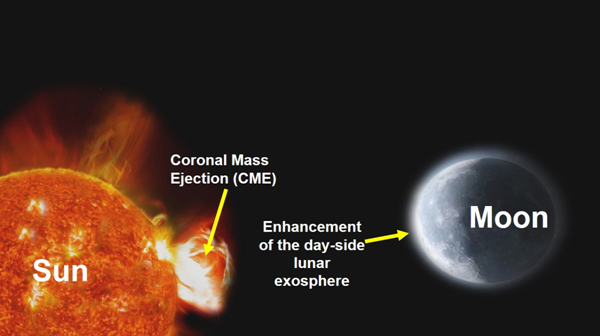In a landmark scientific breakthrough, the Indian Space Research Organisation (ISRO) announced that its lunar orbiter Chandrayaan-2 has made the first-ever observation of the effects of the Coronal Mass Ejections (CMEs) from the Sun on the Moon using its onboard scientific instrument.
The Bengaluru-headquartered space agency has said that this observation would help understand the lunar exosphere, the thin atmosphere of the Moon, and the impact of space weather on its surface.
Launched on 22nd of July in 2019, from Sriharikota using the GSLV-MkIII-M1 rocket, Chandrayaan-2 carried eight experiment payloads. On August 20, 2019, Chandrayaan-2 was successfully inserted into the elliptical orbit around the Moon. Although communication with the Vikram lander was lost during its landing attempt on 7th September 2019, the Orbiter remains fully operational and continues to function in a 100 km x 100 km orbit around the Moon. The ISRO in a statement said, one of the payloads (on-board Chandrayan-2), Chandra’s Atmospheric Compositional Explorer 2 (CHACE 2) has recorded the effects of the Coronal Mass ejections from the Sun on the lunar exosphere. The primary objective of the CHACE-2 payload is to study the composition and distribution of the lunar neutral exosphere and its variability.
During a rare solar event on 10th of May in 2024, a series of CMEs impacted the Moon, leading to a significant increase in the total pressure of the dayside lunar exosphere – the extremely thin atmosphere surrounding the Moon.
ISRO scientists reported that the number density of neutral atoms and molecules in the exosphere increased by more than an order of magnitude, confirming theoretical predictions that had never before been validated through direct observation.
The Moon’s exosphere, classified as a surface boundary exosphere, is highly sensitive to solar activity due to the absence of a global magnetic field. The CME event enhanced the liberation of atoms from the lunar surface, temporarily altering the Moon’s atmospheric conditions.
ISRO said the findings not only deepen scientific understanding of lunar space weather but also have implications for future lunar missions and the design of human habitats on the Moon.
The study, titled “Impact of a Coronal Mass Ejection on the Lunar Exosphere as Observed by CHACE-2 on the Chandrayaan-2 Orbiter”, was published in Geophysical Research Letters on 16th of August, this year.







